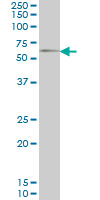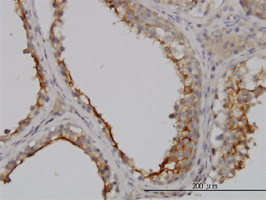GGT1 antibody | 1F9


Mouse anti Human GGT1:Preservative Free
- Product Type
- Monoclonal Antibody
- Clone
- 1F9
- Isotype
- IgG2a
- Specificity
- GGT1
| Mouse anti Human GGT1 antibody, clone 1F9 recognizes human Gamma-glutamyltranspeptidase 1, also known as GGT1, Leukotriene-C4 hydrolase, CD224 or Glutathione hydrolase 1. GGT1 is a 569 amino acid ~65-70 kDa single pass, type II transmembrane glycoprotein. GGT1 forms part of the cell antioxidant defense mechanism. Mutations in the GGT1 gene can lead to the development of Glutathionuria (GLUTH) a disease also known as Gamma-glutamyltranspeptidase deficiency. |
- Target Species
- Human
- Species Cross-Reactivity
-
Target Species Cross Reactivity Mouse Rat - N.B. Antibody reactivity and working conditions may vary between species.
- Product Form
- Purified IgG - liquid
- Preparation
- Purified IgG prepared by affinity chromatography on Protein A from ascites
- Buffer Solution
- Phosphate buffered saline
- Preservative Stabilisers
- None present
- Immunogen
- Recombinant protein corresponding to aa 381-471 of human GGT1
- Approx. Protein Concentrations
- Ig concentration 0.5 mg/ml
- Fusion Partners
- Spleen cells from BALB/c mice were fused with cells from the Sp2/0 myeloma cell line.
- Regulatory
- For research purposes only
- Guarantee
- 12 months from date of despatch
Storage in frost-free freezers is not recommended.
This product should be stored undiluted. Avoid repeated freezing and thawing as this may denature the antibody. Should this product contain a precipitate we recommend microcentrifugation before use.
| Application Name | Verified | Min Dilution | Max Dilution |
|---|---|---|---|
| Immunohistology - Paraffin 1 | 0.1 | 10 ug/ml | |
| Western Blotting | 0.1 | 10 ug/ml |
- 1This product requires antigen retrieval using heat treatment prior to staining of paraffin sections.Sodium citrate buffer pH 6.0 is recommended for this purpose.
References for GGT1 antibody
-
Blackmore, L. et al. (2013) Polymorphisms in ABCB11 and ATP8B1 Associated with Development of Severe Intrahepatic Cholestasis in Hodgkin's Lymphoma.
J Clin Exp Hepatol. 3 (2): 159-61.
- Synonyms
- CD224
- RRID
- AB_2279022
- UniProt
- P19440
- Entrez Gene
- GGT1
- GO Terms
- GO:0005515 protein binding
- GO:0003840 gamma-glutamyltransferase activity
- GO:0016021 integral to membrane
- GO:0006750 glutathione biosynthetic process
- GO:0008415 acyltransferase activity
MCA3141Z
If you cannot find the batch/lot you are looking for please contact our technical support team for assistance.
Please Note: All Products are "FOR RESEARCH PURPOSES ONLY"
View all Anti-Human ProductsAlways be the first to know.
When we launch new products and resources to help you achieve more in the lab.
Yes, sign me up
